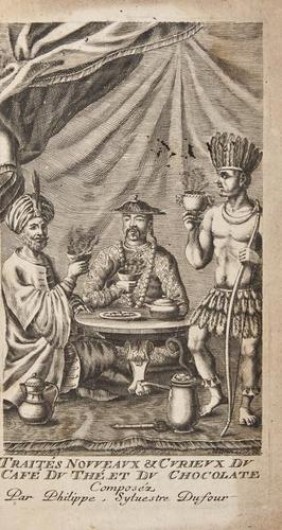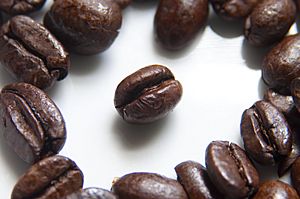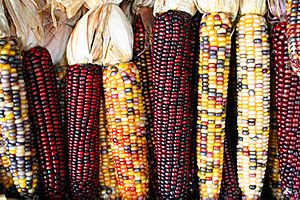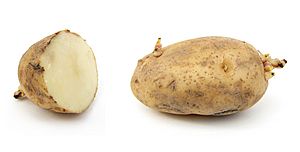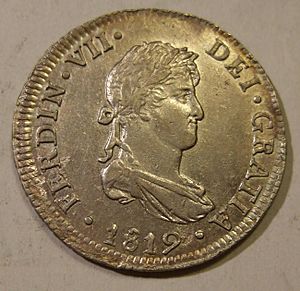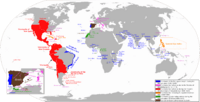Early impact of Mesoamerican goods in Iberian society facts for kids
When Europeans first arrived in the Americas, they discovered many new foods and goods. These items had a huge impact on life back in Spain and Portugal. In the 1500s, people in the Iberian Peninsula (Spain and Portugal) often faced hunger. New foods from the Americas, like corn, potatoes, and tomatoes, helped feed many people.
Other important goods included coffee, sugar, and tobacco. These new items changed how people lived, ate, and even how countries traded. Spain and Portugal became very powerful because other European nations depended on them for these exciting new products. This article will explore how these goods changed society, the economy, and culture.
Contents
Exciting New Foods and Goods
Some of the first goods brought from the Americas were seen as special treats. They were hard to get, so they cost a lot and were mostly enjoyed by rich people.
Chocolate: A Sweet Discovery
Chocolate quickly became one of the most popular new items in Spain and then across Europe. By the late 1500s, chocolate was widely known in the Iberian Peninsula. Spaniards learned to enjoy new flavors like vanilla and pepper, which were often added to chocolate.
In Mesoamerica, the cacao bean (used to make chocolate) was so valuable it was even used as money! Only important people drank chocolate, and it had deep religious meaning. But for the Spanish, it was more about taste and money.
At first, some Spanish people worried that drinking chocolate was linked to old religious practices. But soon, everyone wanted it. By the 1620s, Spain imported thousands of pounds of chocolate every year. Europeans changed the recipe, adding sugar instead of honey. Chocolate started as a luxury for the rich but eventually became a treat for everyone.
Sugar: A Taste of Sweetness
Even though sugar cane came from India, growing it in the Americas had a big effect on Spain. New sugar farms made Spain and Portugal's economies stronger. Sadly, this also led to a huge increase in slave labor, which caused terrible suffering for people from Africa.
At first, sugar was a sign of wealth. Only the rich could afford it. But over time, it became more common. People wanted sugar not just because it tasted good, but also because it showed their social status.
Coffee: The Popular Drink
Coffee originally came from Ethiopia. But when it was grown in the Americas, its popularity exploded in Europe. Arabs first started drinking coffee in the 1400s. Because chocolate was already popular in Spain, coffee quickly became another favorite hot drink.
By the 1700s, more coffee was imported than chocolate! Like chocolate, coffee eventually became popular with all people in Spain and Portugal. Coffee, chocolate, and sugar all helped create a new love for sweet tastes from the Americas.
Tobacco: A New Habit
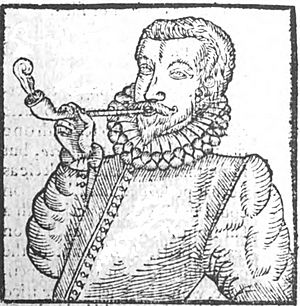
We now know that tobacco is very addictive. This made it a highly desired product in trade. Native tribes in the Americas first used tobacco for special ceremonies, believing it was a gift from their gods.
The Spanish saw tobacco as a product to sell. The demand for tobacco boosted trade for Spain and Portugal, making them more powerful in world trade. The tobacco trade was very important for the economies of the southeastern United States for a long time.
Vanilla: A Sweet Flavor
Vanilla is a flavor that comes from a type of orchid. It was brought to Spain in the 1520s by Hernán Cortés after he conquered the Aztec Empire. The Aztecs had learned about vanilla from the Totonac people in what is now Mexico.
Vanilla quickly became popular as a sweetener in Spain and then across Europe. Along with coffee and chocolate, it fueled a desire for sweet tastes from the New World. Vanilla eventually became a common ingredient in European cooking.
Everyday Foods: New Staples
Many foods from the Americas quickly became important everyday foods, or "staples," in Europe. For example, potatoes became vital in Ireland, and tomatoes in Italy.
Corn: A Versatile Crop
Christopher Columbus saw maize (corn) being grown on all his trips. The Aztecs and Mayans in Central America had been growing many kinds of corn for a long time. Traders brought corn back to Europe in the 1500s. It could grow in many different places, so it quickly became popular.
Corn became a key crop in the Ottoman Empire and the Balkans by the mid-1500s. It was important for feeding the growing Ottoman armies because it produced large harvests. The fact that corn reached the Ottoman Empire so quickly shows how widely it was grown in Spain and Portugal by then.
Squash: An Ancient Food
Native peoples in the Americas had long relied on squash, along with corn and beans, as main foods. The Spanish found squash just as useful and adopted it as a staple. Squash was known in the Ottoman Empire by 1539. This might have happened because Spanish Jews and Muslims, who were forced to leave Spain, brought these goods with them to their new homes.
Beans: A Protein Boost
While beans already existed in Europe and Asia, new types like common, lima, and sieva beans came from the Americas after Columbus's voyages. Native peoples knew that beans were rich in protein. The Spanish quickly added these new beans to their meals.
Tomatoes: From Suspicion to Sauce
Tomatoes were popular in South America, where native peoples in Peru grew and traded them. When Cortez conquered parts of the Americas in the 1500s, tomatoes were brought to Spain and then to Europe. They grew well in Mediterranean climates and quickly became popular.
The first cookbook with tomato recipes was published in Naples in 1692. At first, some people were suspicious of tomatoes and potatoes because they looked similar to a poisonous plant called belladonna. This is why it took a little longer for tomatoes to become popular in Spain compared to other new foods like chocolate and corn.
Turkey: A New Meat
Spaniards found domesticated turkeys in Panama in 1502. These turkeys were part of a trade network among native peoples in Central and South America. The Spanish brought turkeys back to Spain, where they became a popular new meat for many people.
New Peppers: Adding Spice
Christopher Columbus noted at least two new types of peppers after his first voyage. Spain slowly added these new peppers to their food and spread them across Europe. The spread of peppers depended on existing trade routes through Europe, Africa, and Asia. Peppers from the Americas eventually replaced older peppers from Africa and Asia.
Potatoes: A Global Staple
The potato first came from the southern part of Peru. It was the main food for the Inca Empire and became just as popular in the Spanish Empire. Spanish armies and workers adopted potatoes because they were easy to grow. Farmers also started growing them as the 1500s went on. Potatoes spread quickly across Europe. By the 1800s, they had replaced turnips and rutabagas as main food staples.
Other Important Goods
Goods and foods from the Americas also influenced other parts of life in Spain and Portugal.
Cotton: Revolutionizing Fabric
Cotton was first grown in the Indus Valley (modern-day Pakistan). While Europe knew about cotton before the Americas were discovered, its use grew a lot after cotton farms were started in the new American lands. Columbus saw woven cotton fabrics in Nicaragua and Honduras.
Cotton slowly spread into Europe but eventually changed how fabrics were made. This crop, like many others in the Americas, led to a greater demand for slave labor. Cotton farming reached its peak during the Industrial Revolution in Europe.
Flow of Knowledge: New Ways to Grow
Beyond just the goods themselves, the new knowledge from the Americas was very important. Europeans learned how to grow these new foods. This influx of knowledge likely created new jobs in Spain and Portugal and changed how farming worked.
Big Changes for Spain and Portugal
The new goods and foods in the 1500s had a huge impact on Spain and Portugal, not just on what people ate.
Economic Boost and Challenges
Spain and Portugal were the first European countries to trade with the Americas. They became very rich and powerful because they controlled the trade of American goods. People's new desires for coffee and sugar might have even made them work harder to earn money to buy these items.
The demand for new goods also created new jobs. People started making clay pipes for tobacco, special boxes for snuff, and porcelain pots for chocolate.
To make money, Spain and Portugal often used forced labor. When the Pope said native people couldn't be forced to work, they turned to African slavery. The demand for goods like chocolate led to a huge increase in the transatlantic slave trade in the 1500s and 1600s. This had terrible effects on many African nations.
Spain's way of getting wealth from its colonies, by taking raw materials, eventually caused problems. It led to inflation (prices going up) in Spain, making Spanish goods too expensive to compete with others. This also made Spain's colonies suffer, as it was hard to get goods to them, leading to a lot of illegal trade with other countries like England and France.
Religious Adaptations
In Spanish America, people used animal fats for cooking instead of olive oil because there was a lot of meat. The Pope even allowed colonists to skip fasting for 30 years because their diet was so meat-heavy. This made meat a very common part of their meals. Also, the Catholic rule about not eating meat on Fridays led to new ways of cooking with the newly discovered American foods.
Growing Power of the State
Even though Spain and Portugal were supposed to trade separately in the early 1500s, Portuguese merchants still got goods from Spain. This helped Portugal become very strong in the pepper trade in Europe. Portuguese trade with the Americas grew, even with the Treaty of Tordesillas (which divided new lands between Spain and Portugal). This was due to illegal trade and Spain sometimes allowing Portuguese merchants to bring African slaves and other goods into the colonies.
Cities like Venice, Genoa, and Florence in Europe depended on Spain and Portugal for these new American goods. Without these "miracle foods" from the Americas, Europe might not have recovered from the hunger and starvation of the 1500s. The world's dependence on Spain and Portugal for these goods helped them become the two leading world powers in the 1500s and 1600s.
The huge wealth coming from the Americas also led to corruption in Spain and its colonies. Royals, rich people, government officials, and merchants became very wealthy very quickly. This corruption was a big part of how the system worked, with officials helping to move money and share profits.
Cultural Shifts
By the late 1630s, it became common to see paintings that showed items used for chocolate, like special cups and pots. This shows how much chocolate had become a part of everyday life and culture.


